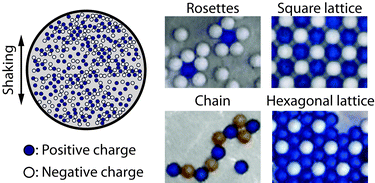A simple two-dimensional model system to study electrostatic-self-assembly†
Abstract
This paper surveys the variables controlling the lattice structure and charge in macroscopic Coulombic crystals made from electrically charged, millimeter-sized

* Corresponding authors
a
Department of Chemistry and Chemical Biology, Harvard University, 12 Oxford St., Cambridge, Massachusetts 02138, USA
E-mail:
gwhitesides@gmwgroup.harvard.edu
Fax: +1 617 495 9430
Tel: +1 617 495 9857
This paper surveys the variables controlling the lattice structure and charge in macroscopic Coulombic crystals made from electrically charged, millimeter-sized

 Please wait while we load your content...
Something went wrong. Try again?
Please wait while we load your content...
Something went wrong. Try again?
R. Cademartiri, C. A. Stan, V. M. Tran, E. Wu, L. Friar, D. Vulis, L. W. Clark, S. Tricard and G. M. Whitesides, Soft Matter, 2012, 8, 9771 DOI: 10.1039/C2SM26192H
To request permission to reproduce material from this article, please go to the Copyright Clearance Center request page.
If you are an author contributing to an RSC publication, you do not need to request permission provided correct acknowledgement is given.
If you are the author of this article, you do not need to request permission to reproduce figures and diagrams provided correct acknowledgement is given. If you want to reproduce the whole article in a third-party publication (excluding your thesis/dissertation for which permission is not required) please go to the Copyright Clearance Center request page.
Read more about how to correctly acknowledge RSC content.
 Fetching data from CrossRef.
Fetching data from CrossRef.
This may take some time to load.
Loading related content
